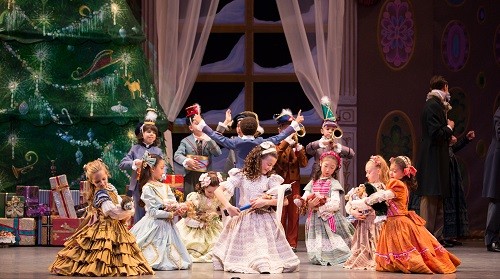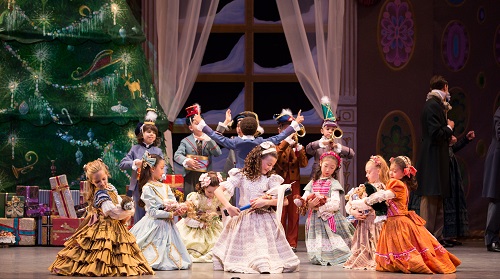 United States Tchaikovsky, George Balanchine’s The Nutcracker: Principals, soloists, corps de ballet of Miami City Ballet, children of Colburn School/The Gabriella Foundation’s everybody dance! Program, Los Angeles Children’s Chorus / Gary Sheldon (conductor), Dorothy Chandler Pavilion, Los Angeles, 9.12.2017. (JRo)
United States Tchaikovsky, George Balanchine’s The Nutcracker: Principals, soloists, corps de ballet of Miami City Ballet, children of Colburn School/The Gabriella Foundation’s everybody dance! Program, Los Angeles Children’s Chorus / Gary Sheldon (conductor), Dorothy Chandler Pavilion, Los Angeles, 9.12.2017. (JRo)

Principal Dancers:
Reyneris Reyes – Dr. Stahlbaum
Lauren Fadeley – Frau Stahlbaum
Renata Adarvez – Marie
Dominick Scherer – Fritz
Didier Bramaz – Herr Drosselmeier
Erick Rojas – Drosselmeier’s nephew/The Nutcracker
Katia Carranza – Sugarplum Fairy
Renato Penteado – Her Cavalier
Divertissements:
Ella Titus – Columbine
Satoki Habuchi – Harlequin
Alex Manning – Soldier
Nathalia Arja & Renan Cerdeiro – Hot Chocolate
Emily Bromberg – Coffee
Alex Manning – Tea
Alexander Peters – Candy Canes
Ashley Knox – Marzipan Shepherdesses
Émilien Rivoire – Mother Ginger
Jennifer Lauren – Dew Drop
Julia Cinquemani & Nicole Stalker – Flowers
Production:
Sets – Ruben Toledo
Costumes – Isabel Toledo
Projections – Wendall K. Harrington
Lighting – James F. Ingalls
There are as many versions of The Nutcracker as there are varieties of sugar candy, all evolving from Lev Ivanov’s 1892 premiere in St. Petersburg. But the production that endures in the hearts and minds of any child or adult who has been fortunate enough to see it is George Balanchine’s 1954 masterpiece. With ravishing choreography for the adult principals and soloists and delightful dancing by an enormous cast of children, Balanchine, with a big assist from Tchaikovsky, managed to conjure the essence of winter, the magnetism of a secular Christmas and the wonder of childhood.
Unless you’re in New York over the holidays, however, seeing NYCB dance this wintry jewel is out of the question. It is, therefore, no small matter that Miami City Ballet, which is licensed to perform Balanchine’s The Nutcracker, has brought it to Los Angeles. Beautifully danced by the company, with the addition of local children, the ballet succeeded on the most important level – dancing. Where it floundered was with the sets and video projections.
Granted, touring is expensive and budgets are slim. Still, Ruben Toledo’s sets were a muddle of odd references and budgetary compromises. Particularly troublesome was Act II’s Land of Sweets. Cloth-covered stage flats were painted with bug-eyed imaginary creatures, and a backdrop of interlaced churros was too brown to convey the idea of sweets. I did like Marie and the Prince’s throne topped with a pineapple, and the idea of a tropical Land of Sweets was worth pursuing.
Isabel Toledo’s traditional Victorian costumes for the first act were lovely, but corners were cut on the second-act costumes and more than a few were underwhelming. As for the video projections – in particular a prolonged view of a dollhouse cutaway of the Stahlbaum house with an angel flying overhead like a helicopter – they were amateurish and awkwardly rendered. In fairness, the children in the audience seemed engaged, but for a more sophisticated audience they were unacceptable. The famous Balanchine Christmas tree, which grows to gigantic height in the original, grew via video projection overlaying a tree constructed of fabric, and it could have been handled better. I’m not sure which of the Toledos was responsible for the Nutcracker mask, a flat cardboard face, but it should be rethought.
Complaints aside, the dancing was excellent. Katia Carranza and Renato Penteado as the Sugarplum Fairy and her Cavalier danced exquisitely from fouettés to fish dives. All the divertissements were solidly performed, and the corps was lovely as snowflakes and flowers. As Drosselmeyer, Didier Bramaz had marvelously expressive hands, and Lauren Fadeley as Frau Stahlbaum added just the right touch of domesticity and elegance needed to usher in the first act.
The heroine of the piece, Marie (Balanchine based his ballet on the original E.T.A. Hoffmann tale rather than the version by Alexandre Dumas père), was charmingly danced and acted by young Renata Adarvez. As Drosselmeyer’s nephew and the prince, Eric Rojas was every inch the danseur noble in training. Dominick Scherer’s Fritz was a natural performer and having more fun than anyone else on stage. If these three children stick with their ballet training, they have a promising future ahead.
Though Mother Ginger’s normally exposed, human face was exchanged for a disturbing blue oversized head with blank eyes, her little Polichinelles, danced by local children, were impressive.
Reflecting on the enduring power of Balanchine’s The Nutcracker, one would have to say it’s due to the role of children in the ballet. In the enchanted world of his creation, children share equal status with adults, both in the narrative and in the real work of constructing the ballet. The audience is transported by this realization as they watch the dance unfold. Children not only identify with the children in the ballet but also glimpse their future, just as Marie and the young prince glimpse their future watching the tender dance of the Sugar Plum Fairy and her Cavalier. Adults are gripped by nostalgia as they see their own childlike yearnings for the perfect Christmas fulfilled – chilly snowfall outside and warm hearth within.
Jane Rosenberg
